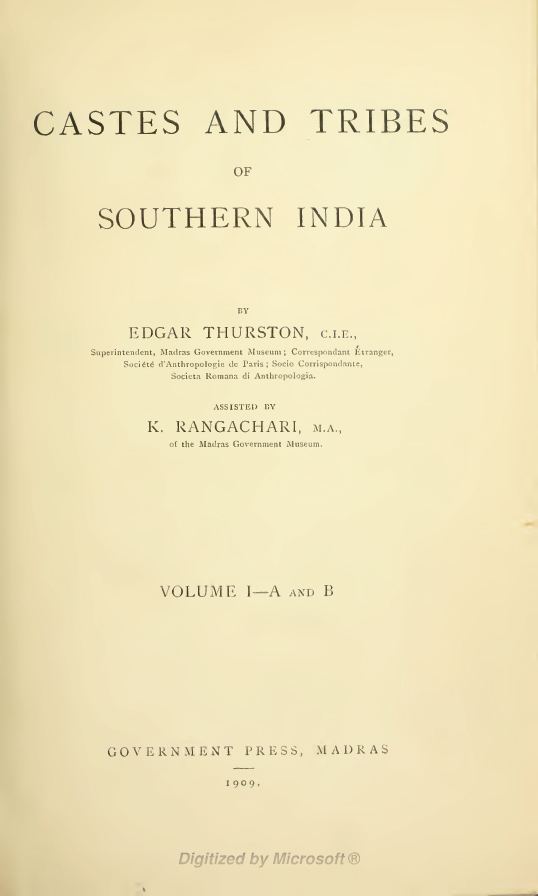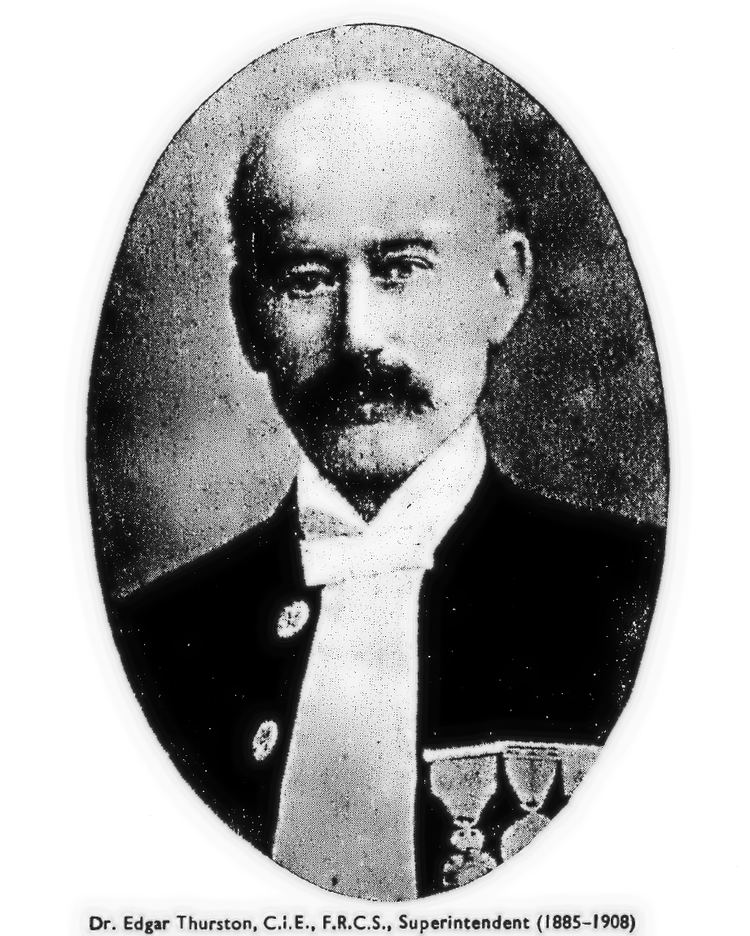Name Edgar Thurston | Alma mater King's College London Succeeded by J. R. Henderson | |
 | ||
Books Castes and Tribes of Southern, Omens and superstitions of souther, The Madras Presiden, Ethnographic notes in southern I, Eurasians of Madras and Mala | ||
Edgar Thurston (1855– 12 October 1935) was a superintendent at the Madras Government Museum who contributed to studies in the zoology, ethnology and botany of India and published works related to his work at the museum. Thurston was educated in medicine and lectured in anatomy at the Madras Medical College while also holding his position at the museum. His early works were on numismatics and geology and these was followed by researches in anthropology and ethnography. He succeeded Frederick S. Mullaly as the superintendent of ethnography for the Madras Presidency.
Contents
- Early life
- Ethnography and geography
- Botany and zoology
- Museum and art
- Later life
- Quotation
- Works
- References

Early life
Edgar Thurston was the son of Charles Bosworth Thurston of Kew, London. Schooled at Eton College, he then studied medicine at King's College, London, qualifying as LRCP in 1877. He worked as a medical officer in Kent County Lunatic Asylum and became a curator of the museum at King's College before joining the Madras Museum in 1885 as a superintendent.
Ethnography and geography
Whereas early European ideas on phrenology were applied to identify mental traits of individuals, advocates of scientific racism used what they considered to be more refined anthropometric measurements to identify castes. Thurston was one such person. He believed that intelligence was inversely proportional to the breadth of the nose and claimed that he scrutinised this as well as handwriting when recruiting clerks in his office. He gave lectures to the students of the Madras University and sometimes to the Madras Police on practical anthropology during the 1890s, and he trained the Madras Police in the use of anthropometry for criminal identification. The Bertillon system had already been incorporated in the Bengal and Madras Police departments by the 1890s and Thurston's training was intended to help the police identify membership of what were then termed as "criminal castes".
In 1901, Thurston was appointed to the Ethnographic Survey of India project, established at that time following the success of Herbert Hope Risley's Ethnographic Survey of Bengal. Risley was an adherent to the theories of scientific racism and had been appointed as director of Ethnology in India. Thurston worked as a part of this project to collect accurate anthropometric measurements. These included a number of measurements of the skull and derived indices or proportions such as the nasal index.
Among other published works, Thurston wrote the seven volumes of Castes and Tribes of Southern India, published in 1909 as part of the Ethnographic Survey of India. In that work he was assisted by K. Rangachari, a colleague from the Madras museum who had also assisted him in a 1906 ethnographic study, Ethnographic Notes in Southern India. Rangachari had supplied most of the forty photographs used in this earlier study. The September 1910 edition of Nature described the 1909 publication as
a monumental record of the varied phases of south Indian tribal life, the traditions, manners and customs of people. Though in some respects it may be corrected or supplemented by future research it will long retain its value as an example of out-door investigation, and will remain a veritable mine of information, which will be of value.
Thurston also authored The Madras Presidency, with Mysore Coorg, and the associated States, being the third volume of the four-volume series "Provincial Geographies of India" which was published between 1913–23 by the Cambridge University Press under the editorship of Thomas Henry Holland. Kavita Philip describes it as combining "a textbook style account of physical and cultural geography with ethnographic detail on habits, customs and festival of the natives".
Botany and zoology
Thurston made numerous collections of plant and animals specimens, many of which were sent to the British Museum. In the late 1880s he was involved in studies on pearl fishing in the Gulf of Mannar. On a visit to Europe he sought to find electric lights that would work at a depth of 20 fathoms so as to assist in pearl harvesting. Some species have been named after him, including the marine organisms Manaria thurstoni (E.A. Smith, 1906), Sepia thurstoni (W. Adam & W. J. Rees, 1966), Mobula thurstoni (Lloyd, 1908), and Ecteinascidia thurstoni (Herdman, 1890). Also, a species of Indian snake, Gerrhopilus thurstoni (Boettger, 1890), is named in his honor.
The standard author abbreviation E.Thurst. is used to indicate this person as the author when citing a botanical name.
Museum and art
Aside from his role at the Madras Museum, Thurston was for some time Honorary Secretary to the now-defunct Fine Arts Society of Madras and was influential in promoting the artistic works of Raja Ravi Varma and his brother C. Raja Raja Varma.
Later life
Thurston was awarded the Kaisar-i-Hind, first class, on 26 June 1902. He was made C.I.E. in 1909. He retired to England and spent his winters at Penzance where he studied the local plants and regularly hosted a New Year party for the local botanists. He died on 12 October 1935 at Penzance.
